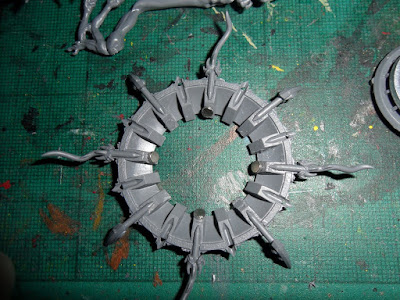Since then I have moved on with my painting techniques to drybrushing, and I have found there is a great way to get details into your miniatures quickly without any prior training. In this tutorial I will show you the basics in getting details into your miniatures whilst watching television (seriously, its that easy).
What you'll need;
- A set of cheap brushes (don't get expensive ones until your confident you won't ruin them, otherwise it will cost you), one of these will need to have a flat end for drybrushing
- Tissue to clean/dry your brush, maybe even one of those spongy pads that come in metal blister packs
- Water to clean your brush
- A Range of paints, such as Light, Medium & Dark Green as used in the example below
- Wash Paint, either the colour to match your scheme such as green, alternatively go with a Black or Brown wash paint to start with
Unfinished German Heer HQ
(awaiting some real attention)
Step 1: Basecoat
First of all you'll need that basecoat, if you have the appropriate primer spray you can save yourself alot of time. In my case I lacked the appropriate primer spray, and had to individually basecoat my miniatures. I started with a dark green paint with the German Heer above.
Step 2: Drybrush
The basics of drybrushing is to pick a flat ended brush, not your typical pointy brush, dab a tiny amount of paint onto it (and I mean tiny), and then wipe most of that paint off again on the tissue until there is only the tiniest bit left. Now quickly and aggressively brush your paint brush across your miniature.
The strokes should be quick, and you should only notice small changes in the shade of you model across the raised areas. Keep repeating this until the shade is what your after. If you use too much paint and you get a large smear of paint on the model, don't worry, this can be remedied if done quickly, get a very wet brush and dab the area to keep it moist and start sponging away at it until the smear of paint has been soaked up.
The strokes should be quick, and you should only notice small changes in the shade of you model across the raised areas. Keep repeating this until the shade is what your after. If you use too much paint and you get a large smear of paint on the model, don't worry, this can be remedied if done quickly, get a very wet brush and dab the area to keep it moist and start sponging away at it until the smear of paint has been soaked up.
For the Paint, I would suggest using a lighter colour paint than the paint that is already on the model, the idea is the make the raised areas stand out.
Step 3: Wash
Now get any old brush and apply your wash paint to the model. Some people prefer to use the Army Painter 'Dip', as this can be a fast way to get your models washed/shaded. Otherwise your wash paints will suffice, here I used the Citadel Biel-tan Green Shade paint.
The wash is very runny, make sure that it seeps into the cracks in your miniature, as your trying to get at the recesses and make them stand out. As I child I believed people hand painted every tiny detail, but even if that were true, this is so much easier and produces great results. Be sure to mop up the excess, otherwise this may take some time to dry.
Step 4: Drybrush again
As before, drybrush your miniature, only this time choose a different paint. In the example above I chose an even lighter green than before and drybrushed alot less aggressively than before. What I was trying to achieve was a transition, where the recesses had the darkest green and the raised areas had the lightest.
Step 5: Experiment
And experiment, change the order around and the paints you have used, see what works best for you. You'll never know what you can achieve unless you try.
Below are a few examples of where drybrushing and washes work quite well;
This guy was painted exactly the same way as above. He was painted as part of a box of 20+ Pioneer Grenadiers, after the above process I painted on the flesh and the metal, applied a wash over said areas and was done.
You'll notice also that concrete feel to the base. What I did here was PVA some sand/debris to the base immediately after I had assembled the miniature, and once it was dry I primed the model (among many others) with a grey primer spray. What little paint made it onto the base as I went along was covered over at the end with grey paint. Again a simple effect that anybody can achieve.
These Concord I had no inspiration to paint at all, and so I painted them mostly whilst watching TV. Basecoated dark blue, I worked my way to lighter colours with a blue wash in the middle. Not bad considering I haven't put any real work into them.
These Ghar were painted as above before and detail painting, and were finished with a light metalic drybrush. The metallic areas received a metal base, nulin oil wash and some metal drybrushing to give it that worn feel.
And that's all for now folks, if you have any questions feel free to comment below. I hope this will make you all more confident at painting your backlog of miniatures.
PeakWargamer Aaron




















